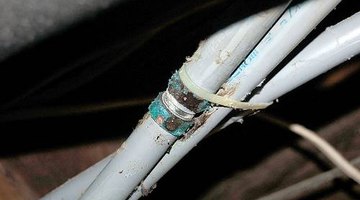How to Identify Polybutylene
From the mid-1970s to the mid-1990s, millions of homes were built using polybutylene pipes for plumbing instead of standard copper.

Polybutylene is a plastic resin material that was used for plumbing pipes because it was cheap, flexible, freeze-resistant and easily held together with a variety of epoxies and metal and plastic plumbing fittings. Unfortunately, the polybutylene pipes started to fail in many homes due to the oxidants in public water supplies such as fluoride and chlorine. These oxidants caused the polybutylene to deteriorate from the inside out, resulting in water leaks and burst pipes. Knowing how to identify polybutylene pipes is important, particularly if you are interested in purchasing an older home.
-
Identify polybutylene by its color. Blue, silvery gray and black pipes were common in 1/2 inch to 1 inch diameters. Blue pipes were used outdoors for primarily cold water, but the silvery gray and black were used interchangeably for both outdoor and indoor uses.
-
Check any suspected polybutylene pipes for identifiable stamping on the flexible, plastic material. Most polybutylene pipes had the letters "PB" and a string of numbers imprinted on them. The most common imprint was "PB2110."
-
Locate prime areas where polybutylene pipes were most often used. Outdoors, these pipes were often found near the main water shut-off valve, at the water meter and entering the home through the basement, concrete slab or crawl space. Indoors, polybutylene was used in the walls and basement ceilings, feeding to sinks, bathtubs and toilets, and could also be found near water heaters.
-
Remove panels under sinks and behind showers, tubs and toilets to expose the plumbing pipes. Sometimes plumbers employed copper or galvanized steel pipe and fittings from the wall to a plumbing fixture but connected to polybutylene pipes behind the walls.
-
Look for copper, aluminum or brass crimp fittings used to link pieces of polybutylene pipes to plumbing joints and fittings. Acetal fittings, a plastic resin often gray or white in color, were also used. The presence of these pipe fittings increases the likelihood that the plumbing pipes are polybutylene.
Tip
Polybutylene was used for potable water only. Therefore, you do not have to inspect pipes used for waste, venting or draining. Hire an inspector to look for polybutylene pipes before purchasing a home built in the mid-1970s to mid-1990s. The presence of polybutylene could be grounds for a lower purchase price or the requirement of plumbing pipe replacement.
Warning
Many insurance companies will not underwrite a policy to protect your home if polybutylene pipes are in use. Have the home inspected before you buy or you could be stuck with an uninsurable home.
The Drip Cap
- From the mid-1970s to the mid-1990s, millions of homes were built using polybutylene pipes for plumbing instead of standard copper.
- The most common imprint was "PB2110." Indoors, polybutylene was used in the walls and basement ceilings, feeding to sinks, bathtubs and toilets, and could also be found near water heaters.
- The presence of these pipe fittings increases the likelihood that the plumbing pipes are polybutylene.
References
Resources
Writer Bio
Tiana Mortimer has been Executive Director for a nonprofit boychoir organization since 1999 and a freelance writer since 2004. Her nonprofit work has been published in a variety of regional publications and she has ghostwritten hundred of articles for the internet. She holds a Bachelor of Business Administration degree in Operations Management and Marketing from the University of Houston.
Photo Credits
- Jennifer Dickert
- Jennifer Dickert
More Articles



